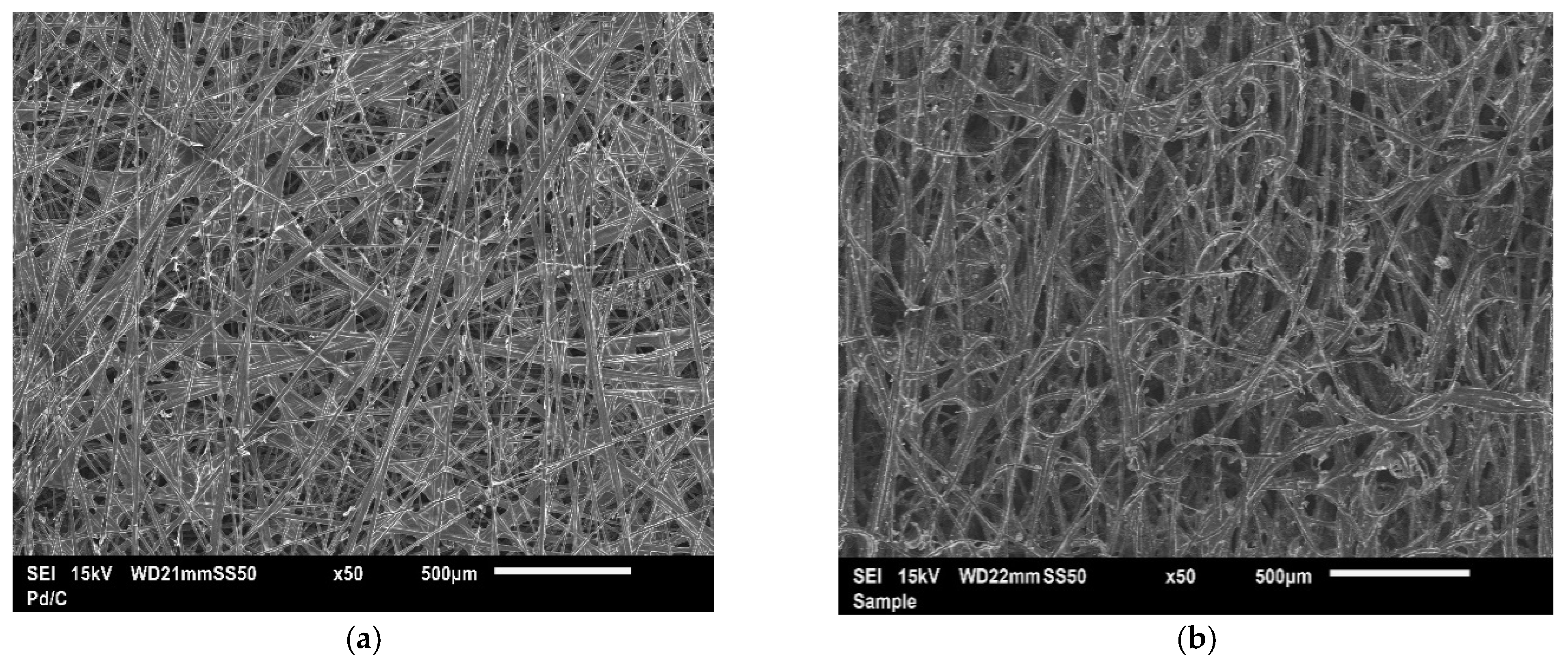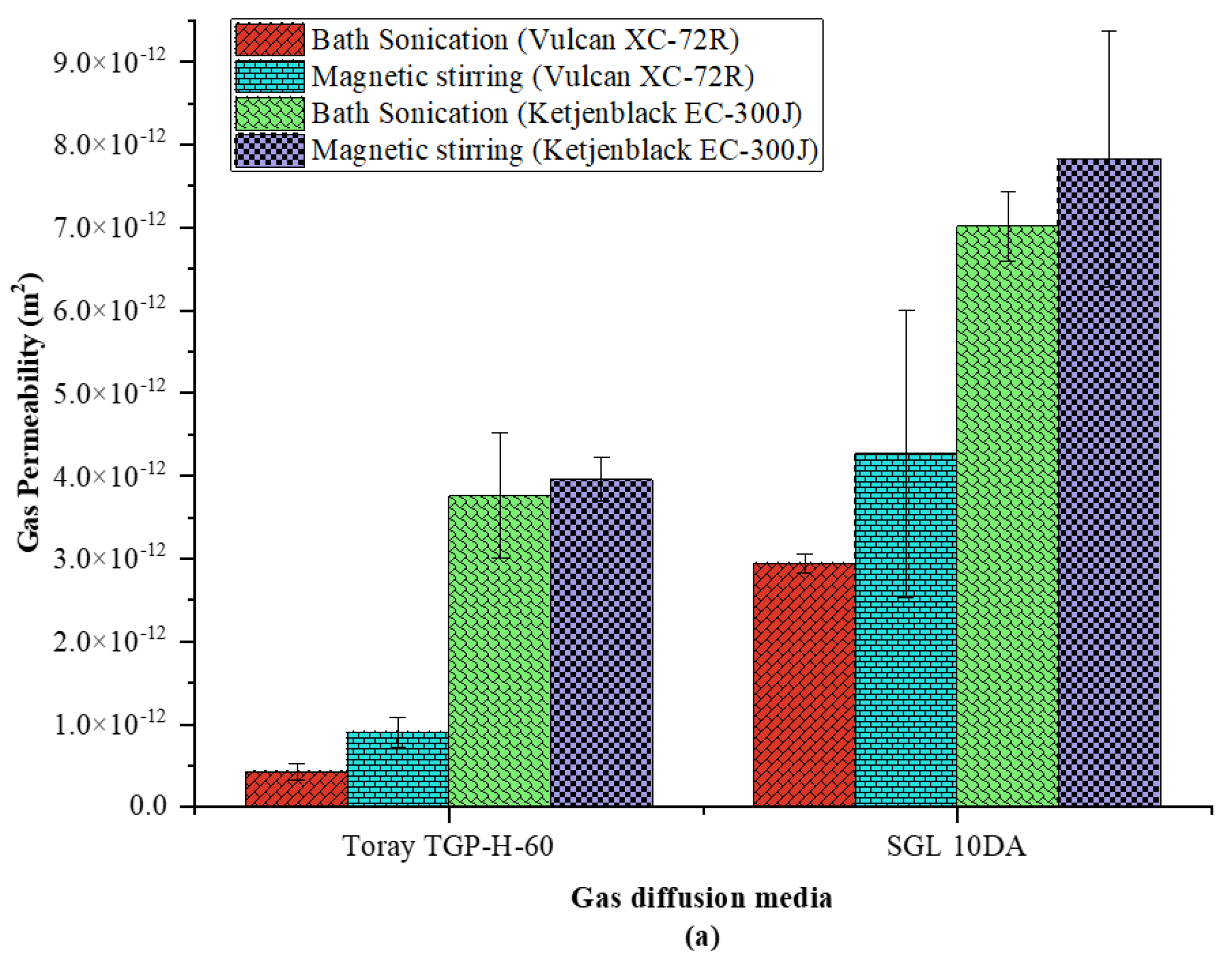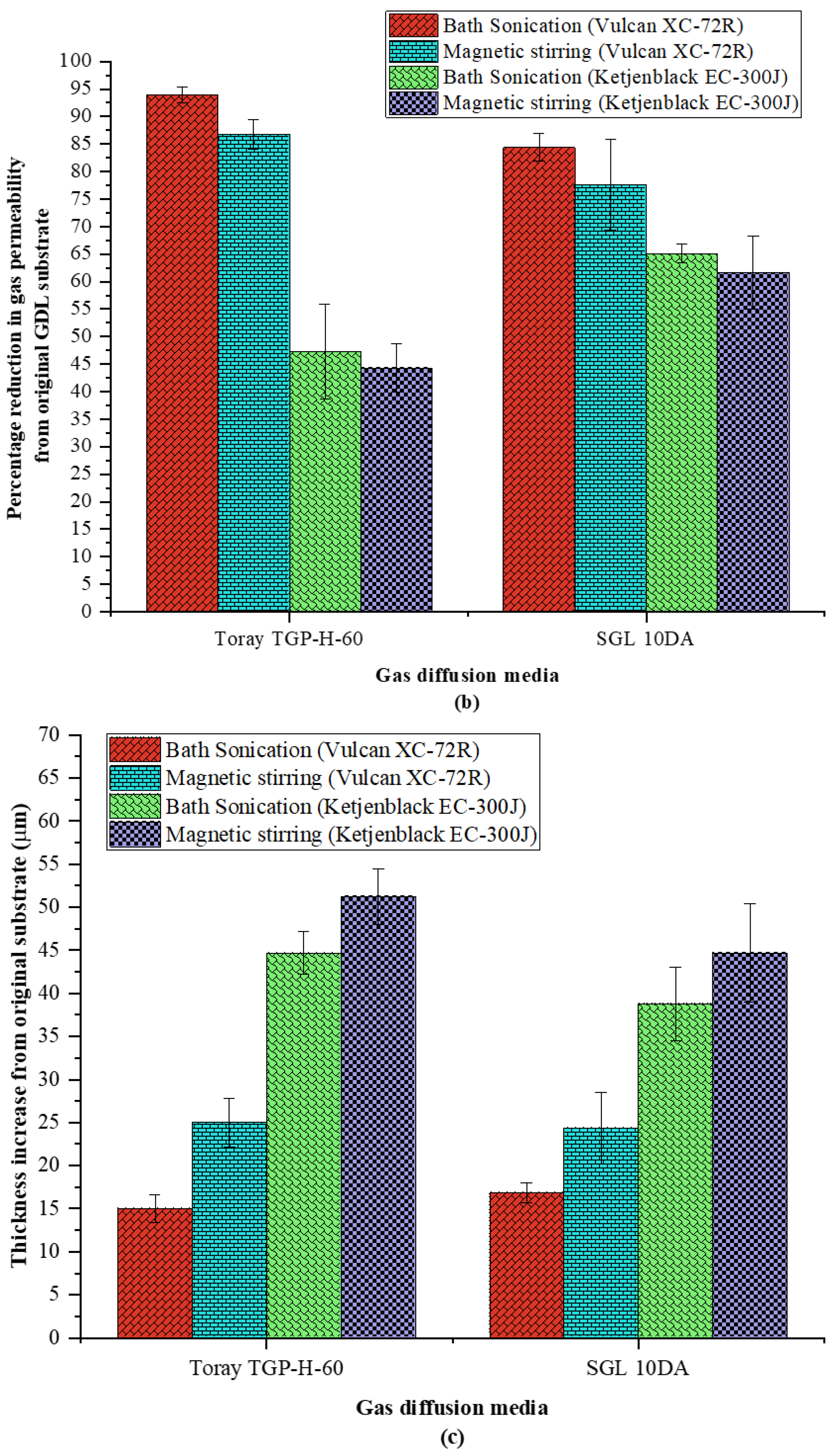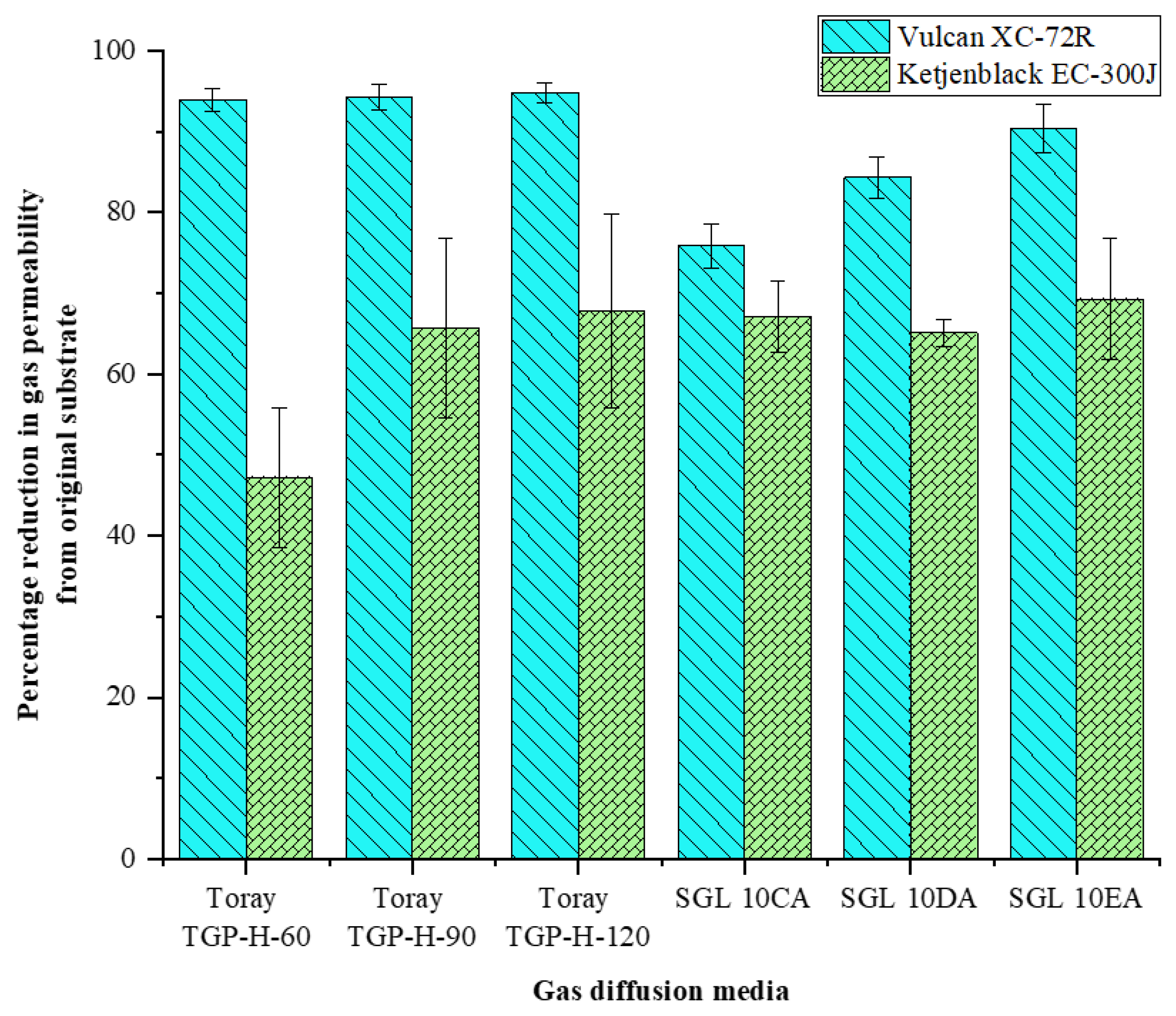Effect of Microporous Layer Ink Homogenisation on the Through-Plane Gas Permeability of PEFC Porous Media
Abstract
1. Introduction
2. Materials and Methods
2.1. Materials
2.2. Methods
3. Results and Discussion
3.1. Through-Plane Gas Permeability of GDLs

| GDL Substrates | Permeability (k × 10−12 m2) | Thickness (μm) | Reported Values of Permeability (k × 10−12 m2) |
|---|---|---|---|
| Toray TGP-H-60 | 7.39 ± 0.15 | 196.88 ± 2.09 | 8.00 [30] |
| SGL 10DA | 19.64 ± 0.85 | 350.94 ± 6.78 | 21.90 [1] |
3.2. Through-Plane Gas Permeability of Gas Diffusion Media
3.2.1. Effect of Ink Homogenisation Techniques
3.2.2. Impact of Homogenisation Time
4. Conclusions
- Bath sonication produced MPLs with a smoother surface and less cracks when compared with the surface morphology produced using magnetic stirring for a high-surface-area carbon powder (Ketjenblack EC-300J). There were no discernible differences in the surface morphology between the two homogenisation techniques for a low-surface-area carbon powder (Vulcan XC-72R);
- Magnetic stirring resulted in an increase in through-plane permeability by a factor of 1.5 to 2 for MPLs composed of Vulcan XC-72R when coated on SGL 10DA and Toray TGP-H-60, respectively. The resulting increase in through-plane gas permeability was attributed to larger aggregates of carbon and PTFE being formed due to the technique used. The homogenisation technique also influenced the thickness of the MPL, where magnetic stirring resulted in thicker structures independent of the GDL substrate;
- The impact of magnetic stirring is more apparent on the through-plane gas permeability for low-surface-area carbon powder (Vulcan XC-72R) and on the surface morphology of high-surface-area carbon powder (Ketjenblack EC-300J);
- Carbon felt-fibre paper (SGL 10DA) GDM showed predictable reductions in through-plane gas permeability for the two carbon powders when compared to previous investigations for SGL 10CA and SGL 10EA, despite a decrease in bath sonication time of one hour. This was attributed to the higher porosity of the carbon felt-fibre paper GDL;
- MPL ink sonication time of three hours resulted in a percentage reduction in through-plane gas permeability from the GDL substrate permeability by 72% for high-surface-area carbon powder (Ketjenblack EC-300J) compared to 47% for a two-hour sonication time; there was a negligible difference in the percentage reduction in through-plane gas permeability between the two bath sonication times for MPLs composed of low-surface-area carbon powder (Vulcan XC-72R).
Author Contributions
Funding
Data Availability Statement
Acknowledgments
Conflicts of Interest
References
- Ismail, M.S.; Damjanovic, T.; Hughes, K.; Ingham, D.B.; Ma, L.; Pourkashanian, M.; Rosli, M. Through-Plane Permeability for Untreated and PTFE-Treated Gas Diffusion Layers in Proton Exchange Membrane Fuel Cells. J. Fuel Cell Sci. Technol. 2010, 7, 051016. [Google Scholar] [CrossRef]
- Ismail, M.; Borman, D.; Damjanovic, T.; Ingham, D.; Pourkashanian, M. On the through-plane permeability of microporous layer-coated gas diffusion layers used in proton exchange membrane fuel cells. Int. J. Hydrogen Energy 2011, 36, 10392–10402. [Google Scholar] [CrossRef]
- Orogbemi, O.; Ingham, D.; Ismail, M.; Hughes, K.; Ma, L.; Pourkashanian, M. The effects of the composition of microporous layers on the permeability of gas diffusion layers used in polymer electrolyte fuel cells. Int. J. Hydrogen Energy 2016, 41, 21345–21351. [Google Scholar] [CrossRef]
- Orogbemi, O.; Ingham, D.; Ismail, M.; Hughes, K.; Ma, L.; Pourkashanian, M. Through-plane gas permeability of gas diffusion layers and microporous layer: Effects of carbon loading and sintering. J. Energy Inst. 2018, 91, 270–278. [Google Scholar] [CrossRef]
- Mukherjee, M.; Bonnet, C.; Lapicque, F. Estimation of through-plane and in-plane gas permeability across gas diffusion layers (GDLs): Comparison with equivalent permeability in bipolar plates and relation to fuel cell performance. Int. J. Hydrogen Energy 2020, 45, 13428–13440. [Google Scholar] [CrossRef]
- Neehall, N.D.; Ismail, M.S.; Hughes, K.J.; Pourkashanian, M. Effect of composition and structure of gas diffusion layer and microporous layer on the through-plane gas permeability of PEFC porous media. Int. J. Energy Res. 2021, 45, 20988–21005. [Google Scholar] [CrossRef]
- Li, C.; Si, D.; Liu, Y.; Zhang, J.; Liu, Y. Water management characteristics of electrospun micro-porous layer in PEMFC under normal temperature and cold start conditions. Int. J. Hydrogen Energy 2021, 46, 11150–11159. [Google Scholar] [CrossRef]
- Bae, I.; Kim, B.; Kim, D.-Y.; Kim, H.; Oh, K.-H. In-plane 2-D patterning of microporous layer by inkjet printing for water management of polymer electrolyte fuel cell. Renew. Energy 2020, 146, 960–967. [Google Scholar] [CrossRef]
- Yang, Y.; Zhou, X.; Li, B.; Zhang, C. Recent progress of the gas diffusion layer in proton exchange membrane fuel cells: Material and structure designs of microporous layer. Int. J. Hydrogen Energy 2021, 46, 4259–4282. [Google Scholar] [CrossRef]
- Zhang, Z.; He, P.; Dai, Y.-J.; Jin, P.-H.; Tao, W.-Q. Study of the mechanical behavior of paper-type GDL in PEMFC based on microstructure morphology. Int. J. Hydrogen Energy 2020, 45, 29379–29394. [Google Scholar] [CrossRef]
- Froning, D.; Reimer, U.; Lehnert, W. Inhomogeneous Distribution of Polytetrafluorethylene in Gas Diffusion Layers of Polymer Electrolyte Fuel Cells. Transp. Porous Media 2021, 136, 843–862. [Google Scholar] [CrossRef]
- Halvorsen, I.J.; Pivac, I.; Bezmalinović, D.; Barbir, F.; Zenith, F. Electrochemical low-frequency impedance spectroscopy algorithm for diagnostics of PEM fuel cell degradation. Int. J. Hydrogen Energy 2020, 45, 1325–1334. [Google Scholar] [CrossRef]
- Islam, M.N.; Shrivastava, U.N.; Atwa, M.; Li, X.; Birss, V.I.; Karan, K. Highly Ordered Nanoporous Carbon Scaffold with Controllable Wettability as the Microporous Layer for Fuel Cells. ACS Appl. Mater. Interfaces 2020, 12, 39215–39226. [Google Scholar] [CrossRef] [PubMed]
- Simon, C.; Kartouzian, D.; Müller, D.; Wilhelm, F.; Gasteiger, H.A. Impact of Microporous Layer Pore Properties on Liquid Water Transport in PEM Fuel Cells: Carbon Black Type and Perforation. J. Electrochem. Soc. 2017, 164, F1697–F1711. [Google Scholar] [CrossRef]
- Liu, C.; Li, S. Performance Enhancement of Proton Exchange Membrane Fuel Cell through Carbon Nanofibers Grown In Situ on Carbon Paper. Molecules 2023, 28, 2810. [Google Scholar] [CrossRef] [PubMed]
- Gostick, J.T.; Fowler, M.W.; Pritzker, M.D.; Ioannidis, M.A.; Behra, L.M. In-plane and through-plane gas permeability of carbon fiber electrode backing layers. J. Power Sources 2006, 162, 228–238. [Google Scholar] [CrossRef]
- El-Kharouf, A.; Mason, T.J.; Brett, D.J.; Pollet, B.G. Ex-situ characterisation of gas diffusion layers for proton exchange membrane fuel cells. J. Power Sources 2012, 218, 393–404. [Google Scholar] [CrossRef]
- Froning, D.; Drakselová, M.; Tocháčková, A.; Kodým, R.; Reimer, U.; Lehnert, W.; Bouzek, K. Anisotropic properties of gas transport in non-woven gas diffusion layers of polymer electrolyte fuel cells. J. Power Sources 2020, 452, 227828. [Google Scholar] [CrossRef]
- Aldakheel, F.; Ismail, M.; Hughes, K.; Ingham, D.; Ma, L.; Pourkashanian, M.; Cumming, D.; Smith, R. Gas permeability, wettability and morphology of gas diffusion layers before and after performing a realistic ex-situ compression test. Renew. Energy 2020, 151, 1082–1091. [Google Scholar] [CrossRef]
- Ismail, M.; Damjanovic, T.; Ingham, D.; Ma, L.; Pourkashanian, M. Effect of polytetrafluoroethylene-treatment and microporous layer-coating on the in-plane permeability of gas diffusion layers used in proton exchange membrane fuel cells. J. Power Sources 2010, 195, 6619–6628. [Google Scholar] [CrossRef]
- Williams, M.V.; Begg, E.; Bonville, L.; Kunz, H.R.; Fenton, J.M. Characterization of Gas Diffusion Layers for PEMFC. J. Electrochem. Soc. 2004, 151, A1173–A1180. [Google Scholar] [CrossRef]
- Gurau, V.; Bluemle, M.J.; De Castro, E.S.; Tsou, Y.-M.; Zawodzinski, T.A.; Mann, J.A. Characterization of transport properties in gas diffusion layers for proton exchange membrane fuel cells: 2. Absolute permeability. J. Power Sources 2007, 165, 793–802. [Google Scholar] [CrossRef]
- Pharoah, J.G. On the permeability of gas diffusion media used in PEM fuel cells. J. Power Sources 2005, 144, 77–82. [Google Scholar] [CrossRef]
- Mangal, P.; Pant, L.M.; Carrigy, N.; Dumontier, M.; Zingan, V.; Mitra, S.; Secanell, M. Experimental study of mass transport in PEMFCs: Through plane permeability and molecular diffusivity in GDLs. Electrochim. Acta 2015, 167, 160–171. [Google Scholar] [CrossRef]
- Zhiani, M.; Kamali, S.; Majidi, S. In-plane gas permeability and thought-plane resistivity of the gas diffusion layer influenced by homogenization technique and its effect on the proton exchange membrane fuel cell cathode performance. Int. J. Hydrogen Energy 2016, 41, 1112–1119. [Google Scholar] [CrossRef]
- Yuan, X.-Z.; Gu, E.; Bredin, R.; Baker, M.; Lee, S.; Biggs, T.; Bock, A.; Banhardt, V.; Russell, J.; Girard, F. Development of a 3-in-1 device to simultaneously measure properties of gas diffusion layer for the quality control of proton exchange membrane fuel cell components. J. Power Sources 2020, 477, 229009. [Google Scholar] [CrossRef]
- Ihonen, J.; Mikkola, M.; Lindbergh, G. Flooding of Gas Diffusion Backing in PEFCs: Physical and electrochemical characterization. J. Electrochem. Soc. 2004, 151, A1152–A1161. [Google Scholar] [CrossRef]
- Gostick, J.T.; Ioannidis, M.A.; Fowler, M.W.; Pritzker, M.D. Wettability and capillary behavior of fibrous gas diffusion media for polymer electrolyte membrane fuel cells. J. Power Sources 2009, 194, 433–444. [Google Scholar] [CrossRef]
- Neehall, N.D. Through-Plane Gas Permeability of Carbon-Based Porous Media in Polymer Electrolyte Fuel Cells. Ph.D. Dissertation, Mechanical Engineering, University of Sheffield, Sheffield, UK, 2019. Available online: https://etheses.whiterose.ac.uk/26987/1/PhD_Thesis-final-rev-NDNeehall-1.pdf (accessed on 20 June 2023).
- Mathias, M.F.; Roth, J.; Fleming, J.; Lehnert, W. Diffusion media materials and characterisation. Handb. Fuel Cells 2010, 3, 517–537. [Google Scholar] [CrossRef]











| Properties | Gas Diffusion Layer | |
|---|---|---|
| Toray TGP-H-60 | SGL 10DA | |
| Thickness (μm) | 190 | 400 |
| Areal weight (g m−2) | - | 100 |
| Porosity (%) | 78 | 84 a |
| PTFE loading (%) | 5 | 20 |
| Properties | Carbon Powders | |
| Ketjenblack EC-300J | Vulcan XC-72R | |
| Pore volume (mL/100 g) | 310–345 | 178 |
| Apparent bulk density (kg m−3) | 125–145 | 20–380 |
| Surface area (m−2 g−1) | 950 | 254 |
| Particle diameter (nm) | 30 | 30 |
Disclaimer/Publisher’s Note: The statements, opinions and data contained in all publications are solely those of the individual author(s) and contributor(s) and not of MDPI and/or the editor(s). MDPI and/or the editor(s) disclaim responsibility for any injury to people or property resulting from any ideas, methods, instructions or products referred to in the content. |
© 2023 by the authors. Licensee MDPI, Basel, Switzerland. This article is an open access article distributed under the terms and conditions of the Creative Commons Attribution (CC BY) license (https://creativecommons.org/licenses/by/4.0/).
Share and Cite
Neehall, N.D.; Ismail, M.S.; Hughes, K.J.; Pourkashanian, M. Effect of Microporous Layer Ink Homogenisation on the Through-Plane Gas Permeability of PEFC Porous Media. Energies 2023, 16, 5944. https://doi.org/10.3390/en16165944
Neehall ND, Ismail MS, Hughes KJ, Pourkashanian M. Effect of Microporous Layer Ink Homogenisation on the Through-Plane Gas Permeability of PEFC Porous Media. Energies. 2023; 16(16):5944. https://doi.org/10.3390/en16165944
Chicago/Turabian StyleNeehall, Narvin D., Mohammed S. Ismail, Kevin J. Hughes, and Mohamed Pourkashanian. 2023. "Effect of Microporous Layer Ink Homogenisation on the Through-Plane Gas Permeability of PEFC Porous Media" Energies 16, no. 16: 5944. https://doi.org/10.3390/en16165944
APA StyleNeehall, N. D., Ismail, M. S., Hughes, K. J., & Pourkashanian, M. (2023). Effect of Microporous Layer Ink Homogenisation on the Through-Plane Gas Permeability of PEFC Porous Media. Energies, 16(16), 5944. https://doi.org/10.3390/en16165944








